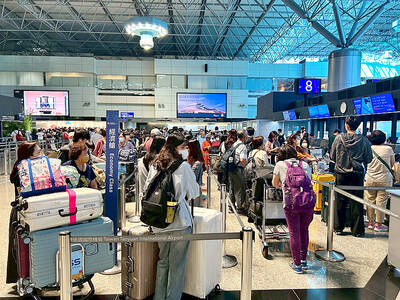Taiwan Railway Corp (TRC) yesterday said that it would add more train services on several routes starting on June 26, following the completion of key infrastructure upgrades.
On the Eastern Trunk Line, two additional Tze-Chiang Express trains would begin operating following the reconstruction of Siaocingshui Bridge (小清水溪橋) between Heren (和仁) and Chongde (崇德) stations in Hualien County, the company said.
The bridge was rebuilt after one of the two tracks was destroyed by Typhoon Gaemi in August last year. With dual-track operations resumed in December last year, travel times between Taipei and Hualien have been significantly reduced, it said.

Photo: CNA
The new service beginning June 26 would run between Shulin Station in New Taipei City and Taitung Station, making stops only in Taipei and Hualien, it added.
Two new Tze-Chiang Express (3000) services would also be added to the schedule on the Western Trunk Line on Saturdays between Cidu (七堵) in Keelung and Changhua County, it said.
That would mean additional passenger capacity on the direct services between Taipei, Taichung’s Fongyuan District (豐原), and Taichung, it added.
The company would also add two carriages to each of the 22 local trains running between Keelung and Hsinchu, increasing them to 10-car formations.
A new local morning service would also be launched between Jhongli (中壢) in Taoyuan and Cidu, aimed at alleviating commuter congestion, it said.
With these adjustments, local train capacity in northern Taiwan is expected to rise by 4.4 percent overall and by 10.3 percent during the morning rush hour, the company said.
The company also plans to increase capacity on 18 local train services in central Taiwan following the completion of a project to extend station platforms to accommodate 10-car trains, up from the current eight-car configuration.
In addition, the routes of two Semi Express services between Cidu and Changhua would be extended to Sinzuoying (新左營) in Kaohsiung on weekends and public holidays, increasing overall local train capacity by 5.8 percent, it said.
In total, 386 train services would operate under the revised schedule, it added.
Group ticket reservations for the new services would open on May 23, with general ticket sales beginning on May 29, it added.
Separately, state-run Taiwan Power Co (Taipower) announced on Sunday that about 26,000 high-voltage electricity users would be subject to higher summer rates from May 16 through mid-October.
Summer electricity rates, introduced in 1989 to encourage electricity conservation during peak demand months, typically apply from June to September.
However, the Ministry of Economic Affairs extended the surcharge period for high and extra high-voltage consumers, such as science parks, department stores and hotels, in 2023, citing the growing challenges of climate change.
While these users represent less than 1 percent of electricity customers in Taiwan, they consume more than 60 percent of the electricity, Taipower said.
Meanwhile, the nation’s 14 million residential and small business users would continue to pay summer rates over the standard period, from June 1 to Sept. 30, it added.

Three batches of banana sauce imported from the Philippines were intercepted at the border after they were found to contain the banned industrial dye Orange G, the Food and Drug Administration (FDA) said yesterday. From today through Sept. 2 next year, all seasoning sauces from the Philippines are to be subject to the FDA’s strictest border inspection, meaning 100 percent testing for illegal dyes before entry is allowed, it said in a statement. Orange G is an industrial coloring agent that is not permitted for food use in Taiwan or internationally, said Cheng Wei-chih (鄭維智), head of the FDA’s Northern Center for

The Chinese military has built landing bridge ships designed to expand its amphibious options for a potential assault on Taiwan, but their combat effectiveness is limited due to their high vulnerability, a defense expert said in an analysis published on Monday. Shen Ming-shih (沈明室), a research fellow at the Institute for National Defense and Security Research, said that the deployment of such vessels as part of the Chinese People’s Liberation Army (PLA) Navy’s East Sea Fleet signals a strong focus on Taiwan. However, the ships are highly vulnerable to precision strikes, which means they could be destroyed before they achieve their intended

About 4.2 million tourist arrivals were recorded in the first half of this year, a 10 percent increase from the same period last year, the Tourism Administration said yesterday. The growth continues to be consistent, with the fourth quarter of this year expected to be the peak in Taiwan, the agency said, adding that it plans to promote Taiwan overseas via partnerships and major events. From January to June, 9.14 million international departures were recorded from Taiwan, an 11 percent increase from the same period last year, with 3.3 million headed for Japan, 1.52 million for China and 832,962 to South Korea,

REWRITING HISTORY: China has been advocating a ‘correct’ interpretation of the victory over Japan that brings the CCP’s contributions to the forefront, an expert said An elderly Chinese war veteran’s shin still bears the mark of a bullet wound he sustained when fighting the Japanese as a teenager, a year before the end of World War II. Eighty years on, Li Jinshui’s scar remains as testimony to the bravery of Chinese troops in a conflict that killed millions of their people. However, the story behind China’s overthrow of the brutal Japanese occupation is deeply contested. Historians broadly agree that credit for victory lies primarily with the Chinese Nationalist Party (KMT)-led Republic of China (ROC) Army. Its leader, Chiang Kai-shek (蔣介石), fled to Taiwan in 1949 after losing a